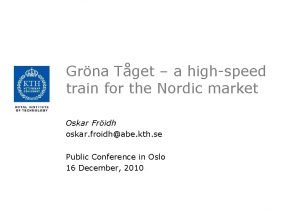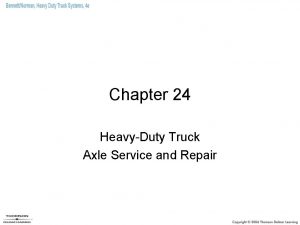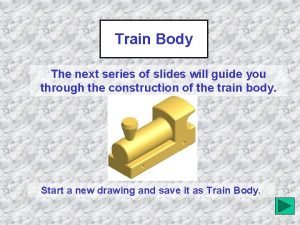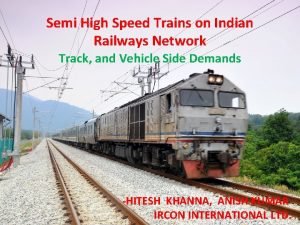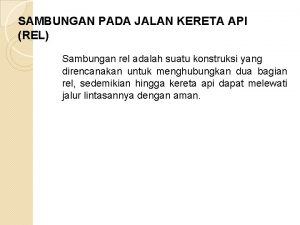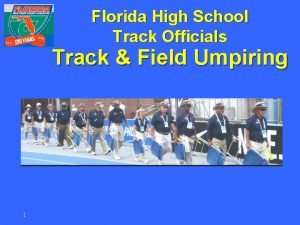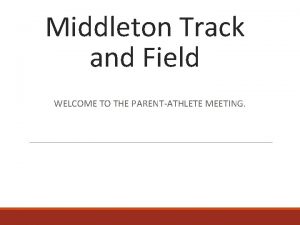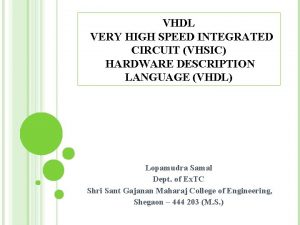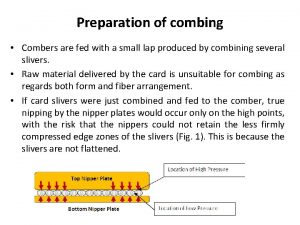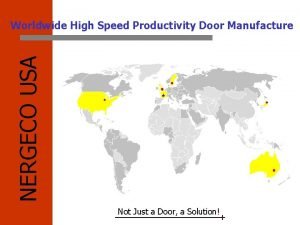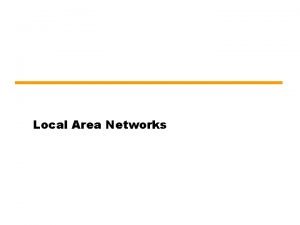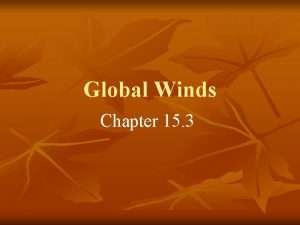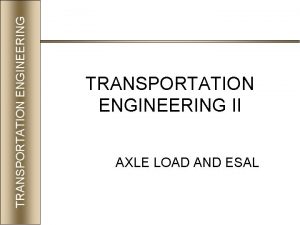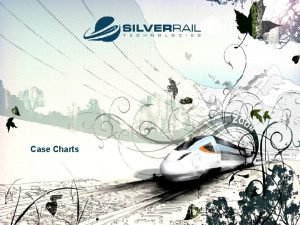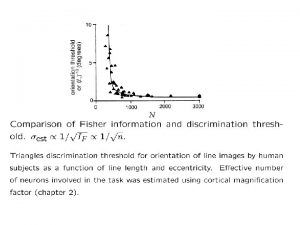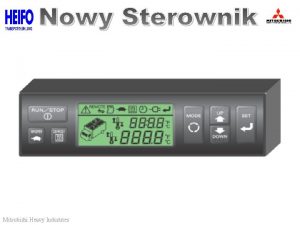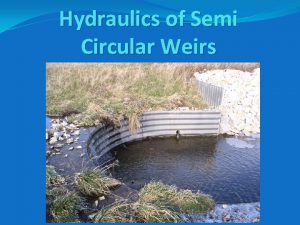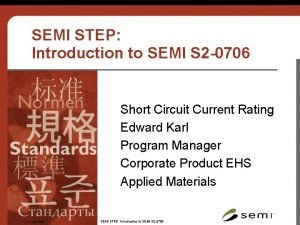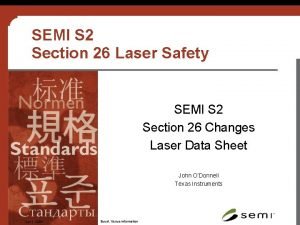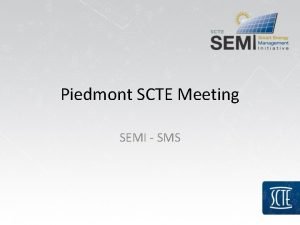Semi high speed train Appropriate Track Heavy axle
















- Slides: 16

Semi high speed train Appropriate Track Heavy axle load train Challenges & possible solutions for appropriate Track technology for mixed traffic regime of Semi high speeds & heavy axle loads BASED ON GLOBAL EXPERIENCE By M. M. Agarwal & K. K Miglani 1

1. Synopsis/Introduction * IR are going ahead in a big way to introduce semi high speed trains which should be cost effective & can be done expediously. On the same track, the Railway are also planning to run heavy axle load trains to improve its economy & make Railway self reliant. * Track, being the basic infrastructure has to be updated/developed to provide appropriate track technology as to ensure that it meets the challenges of mixed traffic of semi high speed as well as of heavy axle loads. * The authors have made a detailed study of track standards required for high speed trains/semi high speed trains as well as trains with heavy axle loads on Indian Railways as well as of other developed railway system of world such as Japan, Germany, France, USA etc. * Based on experience gained by Global Railways including Indian Railway the authors have made an effort to suggest appropriate Track technology, to give best output to IR with safety, comfort & efficiency for mixed traffic regime of Semi high speed & heavy axle load trains. 2

2. Methodology adopted to tackle the problem * * As there is hardly any literature available of running semi high speed trains on IR as well as on world Railways. It is proposed to make a study of high speed railway systems as well as of Semihigh speed trains at global level including Indian railways & try to get an idea of track standards for the same. Similarly, it is proposed to have a study of running heavy axle loads trains on Global railways including Indian Railways & get an Idea of track standards for the same. As track standards/specifications are bit different in moving semihigh speed trains on one side & heavy axle load trains on other side, it is a challenging job for Railway engineers to optimize the track standards so as to move both types of traffic with maximum efficiency. Finally taking an overall view, efforts have been made to suggest appropriate track technology which can give optimum output in mixed traffic regime of semi high speed & heavy axle loads traffic. 3

3. High Speed trains on World Railways * What is a high speed train: UIC defines a high speed train as one that runs over 250 kmph. on dedicated tracks or at over 200 kmph. on upgraded conventional tracks. * (i) History of High Speed Railways The Construction of first high speed railways started in 1959 in Japan of Tokaido-Osaka Section. Operations began on 1 Oct, 1964. This line is the world’s busiest high-speed rail line. (ii) This revolutionary concept of high speed trains was caught on in Europe in the 1980 s , followed by other countries like USA, Russia & lately in China. In the last four decades, there has been spectacular technological progress allowing speeds to be raised to 350 kmph. High speed lines in the world exceeding 250 kmph. is about 30000 kms. (iii) 4

3. 1 Track Structure used on High Speed Routes (HSR) A study has been made of few high speed routes viz SNCF, Japanese Railways, German Railways (DB), Spanish Railways Belgium Railways. From study of these railways it is observed that most of the leading railways operating at High speed use conventional track consisting rails fastened on sleepers with elastic fastenings. The average Track structure being adopted on High speed Railways is given in subsequently table. 3. 2 High Speed Train on Indian Railways (Mumbai-Ahmedabad High Speed rail corridor) The Mumbai-Ahmedabad high-speed rail corridor for running of Bullet trains is an approved high-speed rail corridor project connecting the cities of Mumbai and Ahmedabad in India. * MOU has been signed by the Govt. of India and Japan on 12 Dec, 2015. * The project is estimated to cost 97, 636 crore (US$ 15 billion). Technical Features: * Length of line : 508 kms; * Track gauge: 1, 435 mm (4’ 8½”) Standard Gauge * Speed : 320 to 350 kmph; * Completion Time: 7 Years from 2019 -2016 5

3. 3 Other Features of Special Structures for High Speed Railway 1. Turnouts : When the speed on straight track is above 250 Kmph, High speed turnouts with speed on curved track from 80 to 100 Kmph are warranted. * Turnout : Flatter switch entry; for reduction of lateral forces & increased passenger comfort. Design Movable Nose Crossing for reduction of gap at crossing 2 Bridges : Bridges as well as bridge approaches are the vulnerable points, Strengthen the existing bridge network with minimum disruption to traffic and cost effectiveness. 3. Tunnels : Tunnel cross sections on high speed lines will be guided by the aerodynamic Phenomena in the tunnel; * To reduce this effect, tunnel hoods are specially designed with pressure release shafts. 4. Grade Separation/ : Grade separation/Level Crossings: Level Crossing Normally level crossing is not suitable for high speed train operation 5. Tilting trains on : To overcome the limitation of speed on Curves account of sharp curves particularly on mixed traffic routes, where it is not possible to cant the track, vehicles with tilting suspension system having tilting mechanisms Figure 1: Tilting Train can be used. 6

4. Semi high speed Railways * What is Semi High Speed Trains Semi high speed trains are generally those trains which run at operational speed of 160 to 200 kmph with an average speed of about 110 kmph. * IR are one of few Railways in world, which are planning to run semi high speed trains in big way. * India has recently (5 th April 2016) inaugurated the semi high speed train Gatimaan Express which is India’s first semi high speed train running at top speed of 160 km/h from Delhi to Agra. * Efforts to increase speed to 160 -200 kmph. Indian Railways aims to increase the speed of passenger trains to 160 -200 km/h on dedicated conventional tracks. They intend to improve their existing conventional lines to handle speeds up to 160 km/h, and plan to go for speed above 160 kmph after removing the constraints. Figure 2 Gatimaan Express * Track Structure: RDSO has specified track structure for Semi high speed for speed upto 160 kmph & also for speed from 160 to 200 kmph as give in para 3. 2 of main paper. * Constraints to be renewed for introducing semi high speed trains faster than 160 kmph. for (i) Sharp Curves (ii) Turnouts (iii)Improvement of track 7 geometry:

5. Heavy Axle load trains The phrase ‘Heavy Haul operation’ came into prominence with the first Heavy Haul Conference held in Perth in Western Australia in 1978. A large number of heavy haul trains are being operated in America, Australia, Africa, Europe, Brazil, Scandinavia and UK for last 3 to 4 decades. * Experience of world Railways for design & maintenance of Track structure The problems faced by some of the important heavy haul systems in the world railways, in Construction and operation with special reference to Indian Railways were studied. The case studies are : * Burlington Railways of North America: oldest Heavy Haul operated railway constructed in the decade 1970 -1980. * Fortescue Railway of Western Australia world’s newest Heavy- Haul, railway * Hamersley Railways of North West Australia for maintenance of Heavy Haul Railway Lines. * Based on experience of the world Railway ‘Track structure’ & problem 8 areas have been identified.

* Track Structure was studied & these are given in table subsequently * Problem areas particularly about Formation, Rails, Sleepers, Ballast, Track fittings, Points & crossing as well as track maintenance & their remedial measures were assessed as given in para 4. 2 of the paper. 5. 1 Dedicated Freight Corridor (D. F. C) of IR In order to cater for heavy axle load traffic, Indian Railways have taken an ambitious project of dedicated freight corridor, where only heavy axle load freight trains will run at a speed of 100 kmph * Details of approved DFC Projects Two projects approved as DFC projects are Western Corridor from Delhi to Mumbai (Dadri-Rewari-Vadodara-Mumbai) and Eastern Corridor from Delhi to Howrah (Khurja- Kanpur-Sonnagar-Howrah). * Type of traffic &axle load: 25 tonne double stack container movement with 15000 tonne trailing loads: 30 tonne for bridges. (Completion Date: October 2019) 9

6. Appropriate Track technology for mixed traffic regime of Semi high speed & heavy axle load The studies of Track requirements to run High speed railways, semi high speed railways as well as heavy axle load trains on IR and also for developed global Railways viz Japan, Germany, France, & USA etc as well as UIC standards have given certain ideas to adopt track standards/ specifications & other requirement of track technology for mixed traffic Studies Undertaken The studies are basically for 3 types of traffic requirement * High speed traffic: (This is done as there is very little global experience of semi- high speed traffic) * Semi high speed traffic mostly on IR. * Heavy axle load traffic on world railways. * Heavy axle load traffic on IR (Dedicated Freight Corridor) Decision Based on close analysis of studies undertaken for 4 types of traffic and taking an overall practical, view Appropriate Track standards are suggested as given in next Table 10

Track structure for heavy axle load trains of world Track structure for DFC Recommended track structure for IR 60 to 68 km routes 60 kg 110 UTS 60 kg UIC rails 2. Sleepers About 60 kg/m 71 kg & 90 UTS CWR Concrete sleepers Mono block PRC or Glass fibre sleepers glasses 3. Sleeper Density 1660 to 1724 1660 nos per km. sleepers per km 1660 to 1800 nos. per PSC 1660 Nos. 1660 sleeper km km per km. 4. Fastenings- Double Elastic fastenings type 5. Ballast * Leaf spring/TGV ERC clips mark III Special type noble/Vossloh with rubber pad 6 mm fastening with rubber pads thick Track structure for high speed Railways of World 1. Rail Ballasted track with 30 to 40 mm ballast cusion or ballastless track from 6. Minimum radius varying 4000 m to 6500 of curve m 7. Max. superelevation varying from 150 mm to 180 mm (Cant) 8. Cant deficiency 9. Minimum vertical radius 10. Maximum gradient Track structure for Semi high speed Railways. Mostly PSC Sleepers Some places wooden sleepers of --- PSC sleepers Double Elastic fastening 250/300 mm depth Hard stone ballast with 150 mm sub with 300 mm cysguib ballast iver 150 mm syvballast 7250 m 6000 to 10000 m Machine crushed ballast with 300 mm ballast cushion 1750 m Hard stone ballast having cushion of 250 -300 mm with 150 mm sub-ballast. 140 mm 180 mm -- 165 mm varying from 50 65 mm mm to 112 mm 100 -- 75 mm (In special cases 100 mm) varying 20000 m to 25000 m 24000 m -- 4000 m 0. 15 to 0. 20 % 0. 1 % or 1 in 1000 1 in 400 1750 mm 11

6. 1 Fittings & Fastenings for Appropriate Track Due to heavy axle load, there is possibility of heavy wear & tear on fitting & fastening as per global experience. * Fastening get loose very fast and thereby effecting track geometry. * Rubber pads get damaged early. Heavy crushing of rubber pads as can be seen in figure on main paper. * Glued Insulated Joint start failing because either insulation gets broken or failure of glue which bonds the joints. In order to overcome these problems, the following remedies are suggested (i) Double elastic fastenings are recommended. (ii) Develop better design of rail pads like ‘Three Point Pad’ as seen in figure (iii) Bonded Insulated Joints are worst effected & their design to be further improved by looking after the problems in Figure 3 : Three Point Pad current design, maintenance & operation Points & Crossing: * To be modernised to cater for higher speed of atleast 50 kmph & preferably 75 to 100 kmph. * Thick web, fixed heel type, head hardened switches with flatter entry & cast mangense crossing. * Indian Railways have already designed a new high speed turnout of 1: 12 type which have potential of 50 kmph as given in figure 6. 1 of the paper. 12

6. 2 Recommended Track structure to suit the requirement of mixed traffic Track Items 1. Formation Recommended track structure Formation should be stable so as to take heavy load and also for semi-high speed of 160 to 200 kmph 2. Rail 60 kg UIC rails having 90 UTS are recommended which can be suitable for semi high speed (160 to 200 kmph) as well as high axle load traffic up to 25 tonne axle load. 3. Sleeper Prestressed concrete (PSC) sleepers are recommended. The sleeper density should be 1660 sleeper km. 4. Ballasted track is recommended with hard stone ballast having full ballast cushion of 250 mm to 300 mm with 150 mm sub ballast. IF necessary, work hardening to be done to improve quality of ballast. 5. Fitting & Fastenings (i) Double elastic fastenings are recommended. (ii) To carry heavy axle load & to avoid failure of rubber pad, develop better design of rail pads like ‘Three Point Pad’ (iii) Bonded Insulated Joints due to heavy axle loads these joints are worst effected & their design to be further improved by looking after the problems in current design, maintenance & operation 6. Points & Crossing To be modernised to cater for higher speed of atleast 50 kmph & preferably 75 kmph to 100 kmph. Indian Railways have already designed a new high speed turnout of 1: 12 type which have potential of 50 kmph 7. Maximum Curvature For comfort & safety it should not be sharper than 1° (1750 m) 8. Maximum superelevation In order to provide proper comfort to traveling public as well as to provide safety to passengers/goods, maximum superelevation of 150 mm is recommended. 9. Vertical Curve A very smooth vertical curve is necessary for semi high speed railway to provide maximum comfort to passengers. The minimum vertical radius recommended is 4000 m for safe & smooth ride. 10. Ruling Gradient Considering comfort of passengers & safety of passenger/goods, max. gradient recommended is 1 in 400. 13

6. 3 Recommended Maintenance & Other Features Track Maintenance: * Track has to be maintained mechanically by a fleet of modern track machines. * Regular monitoring of track is required by sophisticated/modern track recording car * Isolated track defects should be attended by off-track tampers. Rail Grinding: Due to heavy loads rail develops defect like Rapid rail wear & excessive wear of rail on curves. Reprofiling should be done by Rail Grinding machine for prolonging rail life as well to prevent defects in rail head. Track Transition areas (Bridge approaches, Level crossings & special track works) * Due to differential settlement, extra track stiffness and differential damping track Components gets damaged quite early. * Extra track maintenance is required of these difficult locations Bridges: Bridges should be designed for heavier loading. Quality of bridge construction and maintenance requires to be improved. Level Crossings: - No Unmanned level crossing - Manned level crossing should be avoided. However, in unavoidable circumstances, it must be interlocked with signals. 14

Fencing: For speed higher than 160 kmph fencing of the entire section may become necessary. For speed upto 160 kmph, fencing can be need based in the vicinity of the habilitation and in approach of major bridges, level crossings etc. Improvement in Rolling Stock LHB coaches are cleared for regular operation upto a maximum speed of 160 kmph. However for higher speed all the coaches will have to be air conditioned to avoid dust ingress and air blast. TALGO Coaches : Trains on conventional rail roads have been the fore-runners for Higher-Speed Trains” in Spain, France, Switzerland Russia. , * Talgo coaches with their lower weight generate lower centrifugal forces and can run faster. * Talgo coaches trains are one of the possible alternatives for running semi-high trains on IR. Tilting trains: To overcome the limitation of speed on account of tight curves vehicles with tilting Figure 4: Talgo Coaches Train suspension system can be used. - For mixed traffic requirement, tilting trains are not recommended for IR due to practical problems based on Global experience. 15

7. Summarising Based on experience of Global Railways including Indian Railways for, (i) high speed routes (ii) semi-high speed routes (iii) Heavy axle load routes including DFC. Appropriate Track-technology has been suggested, consisting of track standards, track maintenance etc which is likely to meet the challenge of mixed traffic regime of running of semi high speed trains as well as heavy axle load trains. THANKS 16
 Oslo to stockholm high speed train
Oslo to stockholm high speed train Heavy duty truck axle repair
Heavy duty truck axle repair Axle peg inventor train
Axle peg inventor train Semi high speed
Semi high speed Coping with emotions while driving includes
Coping with emotions while driving includes Top heavy bottom heavy asymptotes
Top heavy bottom heavy asymptotes Sambungan pada rel pada gambar
Sambungan pada rel pada gambar A toy train engine rests motionless on a track
A toy train engine rests motionless on a track How to solve speed distance and time
How to solve speed distance and time Speed detection of moving vehicle using speed cameras ppt
Speed detection of moving vehicle using speed cameras ppt 4x200 meter relay exchange zones diagram
4x200 meter relay exchange zones diagram Middleton track and field
Middleton track and field Vhsic
Vhsic High speed combers
High speed combers Nergeco door wiring diagram
Nergeco door wiring diagram High speed lans
High speed lans Easterlies and westerlies trade winds
Easterlies and westerlies trade winds
